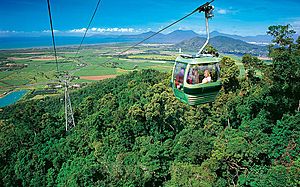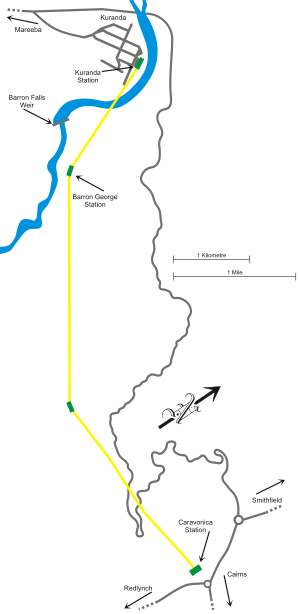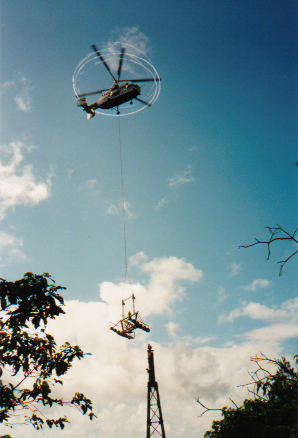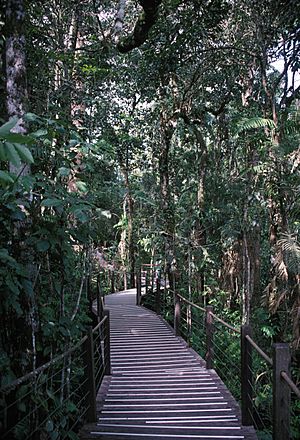Skyrail Rainforest Cableway facts for kids
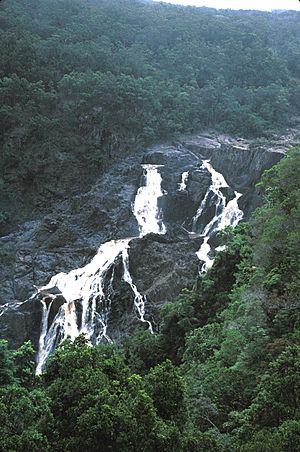
The Skyrail Rainforest Cableway is a super cool way to see the rainforest from above! It's a 7.5 kilometer long cableway that glides over the Barron Gorge National Park in Australia. This park is part of the Wet Tropics of Queensland, which is a special World Heritage Site.
The Skyrail starts in Smithfield near Cairns and ends in Kuranda on the Atherton Tableland. It has won more than 25 awards for being an amazing tourist spot!
When it was finished in 1995, Skyrail was the longest gondola cableway in the world. It takes you right through the Wet Tropics Rainforest, which is the oldest tropical rainforest on Earth – even older than the Amazon rainforest!
The cableway uses six-person gondola cabins that float just above the treetops. A one-way trip takes about 1.5 hours, and a return trip is about 2.5 hours. Along the way, there are two special stops: Red Peak and Barron Falls. At these stations, you can get off and explore the rainforest floor on special boardwalks.
You can even join free tours led by rangers at Red Peak to learn more about this amazing World Heritage area. There's also a "Rainforest Discovery Zone" at Red Peak and a Rainforest Interpretation Centre at Barron Falls. Since 2019, you can visit The Edge Lookout at Barron Falls. This lookout stretches out 160 meters over the Barron Gorge, giving you awesome views of the gorge and the Barron Falls. It even has a glass floor section – super exciting!
Skyrail is known for being very eco-friendly. It was the first tourist attraction in the world to get Platinum EarthCheck Accreditation in 2012. It has won many awards for being a leader in sustainable tourism, which means they work hard to protect the environment while letting people enjoy it.
Contents
Skyrail's Journey Through Time
How the Skyrail Began
The idea for Skyrail came about in 1987. Before building could start, a lot of planning was needed. They talked with 23 different government groups and local communities. They also studied the environment very carefully to make sure everything would be safe for nature.
Skyrail also made an agreement with the Djabugay Tribal Aboriginal Corporation. This was to make sure they protected the important cultural heritage of the Aboriginal people. The Skyrail is owned by the Chapman Group, a family business.
Construction started in June 1994. The cableway officially opened on August 31, 1995, with 47 gondolas. Over the years, Skyrail has been updated to make it even better. In 1997, they added more gondolas, bringing the total to 114. This meant more people could ride each hour!
In 2013, they added 11 "Diamond View" gondolas, which have glass floors so you can see straight down into the rainforest! In 2014, they added the "Canopy Glider," which is an open-air gondola with a ranger guide. Many important people have visited Skyrail, including Queen Elizabeth II and Prince Philip in 2002.
Building the Skyrail: A Big Job
Building the Skyrail was a huge project! Before they started, they checked the area carefully to make sure no rare plants or animals would be harmed. They even collected the topsoil and leaves, then put them back after construction. Any small plants they moved were replanted in their original spots.
The 32 towers that hold up the cableway were built in small clearings. Workers had to clean their tools and shoes very carefully before going into these areas. This helped protect the rainforest from outside germs.
Russian Kamov helicopters were used a lot to carry heavy equipment, building materials, and cement to the tower sites. These helicopters carried 900 tonnes of steel, cement, and other materials to the Barron Falls Station alone! Since no roads were built through the rainforest, workers had to walk to the tower sites every day with their equipment. This shows how much effort went into protecting the environment during construction.
Helping the Rainforest: Skyrail Rainforest Foundation
The Skyrail Rainforest Foundation was started in 2005. Its main goal is to raise money for research and education projects about tropical rainforests. This includes studying rare animals and plants, learning about the forest canopy, and even looking for rainforest species that could help with medical research.
The foundation also helps students and teachers who want to research how to protect the rainforest. Since it began, the foundation has given over AU$300,000 to different research projects.
Cool Facts About Skyrail
- Skyrail is located in the World Heritage listed Wet Tropics area, home to the world's oldest tropical rainforest.
- Some of the ancient plants in this rainforest are 130 million years old! They were around when dinosaurs walked the Earth.
- The cableway can go as fast as 18 kilometers per hour, but it usually moves slower. This gives you more time to enjoy the amazing rainforest views.
- There are 32 towers in total. The tallest one, Tower 6, is 45 meters high.
- Red Peak is the highest station, sitting 545 meters above sea level.
- The steepest part of the cableway has a slope of 19 degrees.
- The Skyrail uses 15 kilometers of strong steel rope. This rope weighs more than 100 cars!
- There's a special communication cable running between the towers. It carries all the voice and safety messages.
- The cableway is powered by strong electric motors at the Kuranda and Smithfield Stations. They also have backup diesel motors and other auxiliary drives, just in case.
- You can even see live views from the cableway! There are two webcams on top of Towers 7 and 25 that show what's happening.
Images for kids


